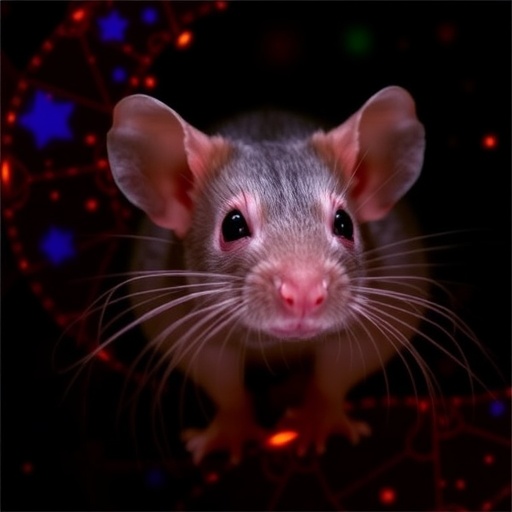
Neural circuits orchestrate complex behaviors by integrating diverse internal states with external environmental cues. A groundbreaking study published in Nature in 2025 by Salay, Tsao, and Anderson illuminates a previously obscure neural pathway that governs mating behavior in male mice by combining sexual drive with direct social contact, revealing the delicate neurobiological choreography underlying reproductive actions.
At the core of this research is the parvocellular subparafascicular nucleus of the thalamus (SPFp), a brain region implicated in processing multisensory information. Through meticulous head-fixed electrophysiological recordings, the scientists demonstrated that SPFp neurons become selectively active when male mice physically contact an object, but crucially, this activation depends on concurrent stimulation of the medial preoptic area (MPOA), a key node regulating sexual motivation. This finding raised the intriguing question: do these SPFp neurons function similarly in freely interacting animals during natural mating encounters?
To explore this, the researchers deployed the immediate early gene marker c-Fos, a well-established indicator of neuronal activation, to map the activity of SPFp neurons after male mice engaged in copulation versus mere exposure to a female behind a physical barrier allowing no direct contact. The results were striking—copulatory interactions vastly augmented c-Fos expression within the SPFp, while the no-contact condition elicited negligible labeling. This dichotomy underscored that physical social contact combined with sexual drive robustly activates these neurons, implicating them further in mating behaviors.
Identifying a genetic marker for SPFp neurons critical in mating was the next imperative step to facilitate targeted manipulation and in vivo calcium imaging. The team turned their attention to parathyroid hormone 2 (Pth2), also known as the tuberoinfundibular peptide of 39 residues (TIP39). Previous work linked Pth2 expression to neurons activated during male reproductive behaviors, yet its dynamics and causal involvement remained unclear. Leveraging a Pth2-Cre mouse line crossed with a Cre-dependent fluorescent reporter strain, they delineated a remarkably specific population of SPFp neurons expressing Pth2, precisely aligning with the electrophysiologically defined regions.
Notably, comprehensive analysis revealed that approximately 90% of Pth2-expressing SPFp neurons were c-Fos-positive following mating, whereas control no-contact conditions resulted in only a minor fraction showing activation. Conversely, the majority of mating-activated SPFp neurons harbored Pth2 transcripts, confirming the tight association between Pth2 expression and mating-related neural activation. Further examination using fluorescent in situ hybridization (FISH) established that these Pth2-positive SPFp cells are predominantly glutamatergic, suggesting an excitatory integrative role within the mating circuitry.
The interplay between local and long-range inputs sculpting this neural ensemble was dissected with sophisticated monosynaptic rabies viral tracing techniques. Given the hypothesis that Pth2-expressing SPFp neurons serve as integrative nodes, the investigators predicted these cells would receive direct excitatory inputs from the spinal trigeminal nucleus (SpV) and indirect inhibitory modulation via MPOA inhibitory neurons acting through local SPFp interneurons. Rabies virus-mediated tracing confirmed abundant monosynaptic inputs from SpV to Pth2-positive SPFp neurons, yet notably sparse direct inputs from the MPOA. This anatomical configuration supports a polysynaptic gating mechanism rather than a direct one.
Intriguingly, triple-label fluorescence imaging revealed that local SPFp inhibitory interneurons expressing vesicular GABA transporter (Vgat) form monosynaptic connections onto Pth2-positive neurons. The existence of this local inhibitory microcircuit provides a framework for how inputs from MPOA inhibitory neurons might influence Pth2-positive SPFp cells indirectly. Previous data had demonstrated direct MPOA GABAergic projections targeting these local SPFp inhibitory interneurons, setting up a disinhibitory circuit motif where MPOA activation suppresses local inhibition, thereby facilitating the excitatory output of Pth2-positive neurons.
This discovery illuminates a di-synaptic disinhibitory pathway: MPOA Vgat-positive neurons inhibit SPFp local inhibitory interneurons, which themselves inhibit glutamatergic Pth2-positive SPFp neurons. Activation of the MPOA during heightened sexual drive would thus disinhibit these integrative SPFp neurons, amplifying their responsiveness to tactile social contact cues received via SpV pathways. This circuit elegantly integrates internal motivational states with external somatosensory inputs to selectively gate mating behavior.
The implications of these findings extend beyond basic reproductive biology. They exemplify how neural circuits orchestrate behaviorally relevant decision-making by overlaying motivational context onto sensory signals, ensuring that costly behaviors like mating occur only under conducive internal and external conditions. The identification of Pth2 as a marker for these integrative neurons permits precise circuit dissection using genetically targeted tools, opening avenues to manipulate mating drive and social contact processing in vivo with unprecedented specificity.
Moreover, the experimental strategy combining immediate early gene mapping, genetic labeling, electrophysiology, viral tracing, and in situ hybridization sets a new standard for mechanistic studies of social behavior circuits. It underscores the power of intersectional approaches in delineating functionally defined neuronal subpopulations within complex brain nuclei. Future investigations may unravel how dysfunctions within this circuit contribute to social deficits observed in neuropsychiatric disorders.
This innovative research advances our understanding of the neural substrates of mating by revealing a circuit logic wherein sexual drive states regulate the excitability of SPFp neurons processing social tactile stimuli. Such findings bridge the gap between cellular neuroscience and ethologically relevant behaviors, offering profound insights into how brains translate internal needs and external stimuli into adaptive actions. As neuroscience continues to decode the intricate wiring of social circuits, studies like this pave the way toward unraveling the biological basis of social behavior at the molecular, cellular, and systems levels.
In summary, the work by Salay, Tsao, and Anderson compellingly demonstrates that Pth2-expressing neurons within the SPFp function as integrative hubs, activated by direct social contact during mating, and their activity is tightly controlled through a disinhibitory circuit involving MPOA inhibitory projections and local inhibitory interneurons. This circuit motif ensures that mating-related neuronal activation is precisely gated by the interplay of sexual drive and tactile social cues, exemplifying sophisticated neural control over reproductive behaviors.
These insights not only deepen our comprehension of thalamic involvement in social behaviors but also highlight the critical role neuropeptide-expressing excitatory neurons play in integrating multimodal signals within subcortical brain regions. By piecing together these complex neural interactions, the study offers a paradigm for understanding how internal states modulate the neural processing of social stimuli to drive species-specific behaviors essential for survival and reproduction.
Subject of Research:
Neural circuits regulating mating behavior by integrating sexual drive states and tactile social contact in male mice, specifically focusing on Pth2-expressing neurons in the parvocellular subparafascicular nucleus of the thalamus.
Article Title:
A circuit that integrates drive state and social contact to gate mating.
Article References:
Salay, L.D., Tsao, D.Y. & Anderson, D.J. A circuit that integrates drive state and social contact to gate mating. Nature (2025). https://doi.org/10.1038/s41586-025-09327-x
Image Credits:
AI Generated
Tags: c-Fos gene marker in neurosciencedirect social contact effects on behaviorelectrophysiological recordings in animal studiesimplications of mating behavior researchmale mice reproductive actionsmedial preoptic area stimulationmultisensory information processing in the brainneural circuits in mating behaviorneurobiological pathways in matingparvocellular subparafascicular nucleusreproductive behavior in freely interacting animalssexual drive and social contact




